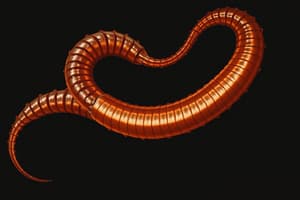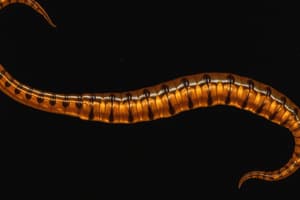Podcast
Questions and Answers
What is the primary site of infection for dirofilaria immitus?
What is the primary site of infection for dirofilaria immitus?
- Intestines
- Kidneys
- Liver
- Pulmonary arterial tree (correct)
Which bacteria has a symbiotic relationship with D. immitis, improving the adult heartworms' fertility and fortitude?
Which bacteria has a symbiotic relationship with D. immitis, improving the adult heartworms' fertility and fortitude?
- Staphylococcus aureus
- Escherichia coli
- Wolbachia (correct)
- Clostridium difficile
What specific protein produced by Wolbachia contributes to immune/inflammatory responses in infected animals?
What specific protein produced by Wolbachia contributes to immune/inflammatory responses in infected animals?
- Filarial Protein (FP)
- Wolbachia Surface Protein (WSP) (correct)
- Heartworm Associated Protein (HAP)
- Dirofilarial Antigen (DA)
In what part of the body does Wolbachia Surface Protein (WSP) primarily target?
In what part of the body does Wolbachia Surface Protein (WSP) primarily target?
What is the role of Wolbachia in the life cycle of dirofilaria immitus?
What is the role of Wolbachia in the life cycle of dirofilaria immitus?
Which of the following is NOT a listed objective related to Heartworm Disease in the text provided?
Which of the following is NOT a listed objective related to Heartworm Disease in the text provided?
What is a common recommendation by Dr. Mac for animals that are heartworm positive?
What is a common recommendation by Dr. Mac for animals that are heartworm positive?
Which diagnostic technique is commonly used to assess for the presence of worms in the pulmonary arteries?
Which diagnostic technique is commonly used to assess for the presence of worms in the pulmonary arteries?
What is a common clinical presentation of Heartworm Associated Respiratory Disease (HARD) in dogs?
What is a common clinical presentation of Heartworm Associated Respiratory Disease (HARD) in dogs?
Which medication is commonly prescribed for Heartworm Associated Respiratory Disease (HARD) in cats?
Which medication is commonly prescribed for Heartworm Associated Respiratory Disease (HARD) in cats?
What is a common finding in imaging studies for animals with heartworm disease?
What is a common finding in imaging studies for animals with heartworm disease?
What is considered pathognomonic for heartworm disease in histopathology?
What is considered pathognomonic for heartworm disease in histopathology?
What is the recommended protocol for treating Class III heartworm disease in dogs?
What is the recommended protocol for treating Class III heartworm disease in dogs?
What is the concern associated with continuous monthly administration of prophylactic doses of macrocyclic lactone alone?
What is the concern associated with continuous monthly administration of prophylactic doses of macrocyclic lactone alone?
Which area is specified for the administration of Melarsomine Dihydrochloride?
Which area is specified for the administration of Melarsomine Dihydrochloride?
Why is it important to check Microfilaria (MF) status before treatment?
Why is it important to check Microfilaria (MF) status before treatment?
What is the purpose of the two-injection protocol recommended for Class I and II heartworm disease?
What is the purpose of the two-injection protocol recommended for Class I and II heartworm disease?
According to Keister et al, 1992; Vezzoni et al, 1992, how long does it take for adult heartworms to be 95% eliminated with continuous administration of macrocyclic lactones?
According to Keister et al, 1992; Vezzoni et al, 1992, how long does it take for adult heartworms to be 95% eliminated with continuous administration of macrocyclic lactones?
What is the purpose of exercise restriction in heartworm treatment?
What is the purpose of exercise restriction in heartworm treatment?
When should the HW Antigen test be repeated post-adulticidal therapy if the initial test at 6 months is still positive?
When should the HW Antigen test be repeated post-adulticidal therapy if the initial test at 6 months is still positive?
What may be the reason behind a positive microfilaria (MF) test 6 months post-treatment?
What may be the reason behind a positive microfilaria (MF) test 6 months post-treatment?
When do thromboembolic events typically occur post-injection in heartworm-infected animals?
When do thromboembolic events typically occur post-injection in heartworm-infected animals?
What are some common clinical signs associated with thromboembolic complications in heartworm-infected animals?
What are some common clinical signs associated with thromboembolic complications in heartworm-infected animals?
How long will worms continue dying after adulticidal therapy?
How long will worms continue dying after adulticidal therapy?
Which host serves as the definitive host for heartworms?
Which host serves as the definitive host for heartworms?
When should heat treatment be recommended for heartworm diagnosis?
When should heat treatment be recommended for heartworm diagnosis?
What is the primary purpose of the Heartworm Antibody Test?
What is the primary purpose of the Heartworm Antibody Test?
In heartworm testing for dogs, when is microfilaria testing typically recommended?
In heartworm testing for dogs, when is microfilaria testing typically recommended?
Which of the following is NOT a common clinical sign of heartworm disease in dogs?
Which of the following is NOT a common clinical sign of heartworm disease in dogs?
What type of test is recommended for cats before starting preventative treatment?
What type of test is recommended for cats before starting preventative treatment?
Which of the following animals can act as intermediate hosts for heartworms?
Which of the following animals can act as intermediate hosts for heartworms?
What does the presence of antibodies indicate in heartworm infection?
What does the presence of antibodies indicate in heartworm infection?
When should heartworm testing be conducted in dogs according to the provided text?
When should heartworm testing be conducted in dogs according to the provided text?




